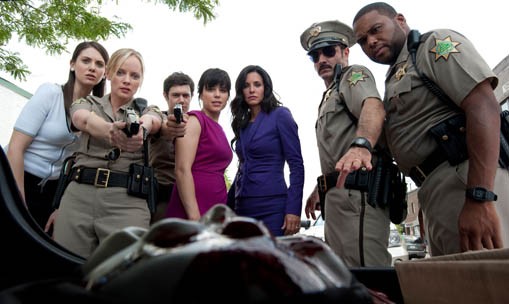Culture
“Scre4m” if you can hear them

Scre4m
dir. Wes Craven
Release Date: Apr 15, 11
- 1
- 2
- 3
- 4
- 5
- 6
- 7
- 8
- 9
- 10
Scre4m begins with an impish sequence, in which Wes Craven and Kevin Williamson (the writer-director tandem who temporarily resuscitated the slasher film 15 years ago) address not only the changing face of horror films since the last Scream installment over a decade ago, but also the series’ descent into smug meta-theatre. This is one of the film’s strongest scenes, but also a dicey gambit, as it’s reminiscent of the Mr. Charles sequence in Inception: By letting audiences in on the joke and showing his hand, Craven takes the risk of putting the film’s ultimate lack of depth front and center before the opening titles have a chance to roll.
Though this is easily the strongest Scream since at least the second, if not the original, it also feels more like a relic than anybody involved evidently hoped it would. Once you’ve sent up genre film fans (the party in the original, the marathon of “Stab” films based on the original murders that happens here), genre film conventions and the choices characters too frequently make to facilitate those conventions, there’s not a lot left to lampoon. Which is why, when Sydney (Neve Campbell, not aged a day in at least a decade now) returns to Woodsboro for the anniversary of all those Ghostface murders, the immediate instinct is just to grab her by the shoulders, shake her and ask how she’s learned absolutely nothing after all this time.
Of course, Sydney’s return means the return of Ghostface and his knife, still such an effectively brutal figure after all this time. Not only does Ghostface hold up as an effective visual cue for terror, but in a time where even killers with good humor are being turned into dour machines of teenager murder (last year’s abysmal Nightmare On Elm Street), it’s almost refreshing to see a murderer who can still laugh. Needless to say, Ghostface begins to pile up the quasi-celebrities, and for a while Scre4m brings back the thrill of trying to figure out which shifty-eyed (or least shifty-eyed) character is the real villain. Courtney Cox steals scenes, again, as Gale Weathers, the seen-it-all reporter, especially when engaging in verbal sparring sessions with Chief Riley (David Arquette). There’s an underlying tension to these scenes, knowing the fiery divorce those two went through off-camera while shooting the film, but Cox really shines, and especially when Sydney doesn’t have much to do for a good chunk of the running time save for look forlorn (at least until an almost comical burst of heroism), Gale is allowed to carry much of the seriocomic weight, and does this more than ably.
The young blood is a mixed bag, as the cast runs so deep that there’s not much time for character development, as if this matters. That said, Emma Roberts does good work in Campbell’s role from the first film, as the everyday girl forced to watch everybody around her get hacked up. Faring equally well in the know-it-all role is an unusually likable Hayden Panetierre; the scene in which she fires off a furious volley of genre titles to appease Ghostface is one of the best acted, and probably best written, moments of the whole movie. Kudos are also due to Marley Shelton, who turns a bit role as Chief Riley’s smitten underling and wrings every bit of possible comedy out of it. There’s just enough development that we sort of care about these people getting stabbed to death, but that’s not this movie’s m.o. anyway.
All of this said, there’s one inescapable problem with Scre4m: It’s a ‘90s movie through and through. Horror has changed, and even if you think it’s changed for the worse and welcome a throwback to slow-burning tension and the unbridled terror of anonymous phone calls, there’s something inherently hokey about this film that’s exacerbated by Craven’s constant need to draw attention to that hokiness. There’s also the logic hole that’s existed since the first movie, the one in which using schlock conventions to send up a genre doesn’t change the fact that Craven has now built an entire horror franchise around totally generic horror plotting. For all the “New decade, new rules” posturing, not much has changed. The violence is sadly almost pedestrian in comparison to what’s come since, and even the dark comedy, the one thing that’s always set the series apart, is now rooted in clichés that Scream itself created. This series exists to lampoon a subgenre that’s no longer in fashion, so in a sense Scre4m only exists to take potshots at itself, like an uncle who still tells the story of his winning touchdown pass in high school to an indifferent family at Thanksgiving. Sobering, no?